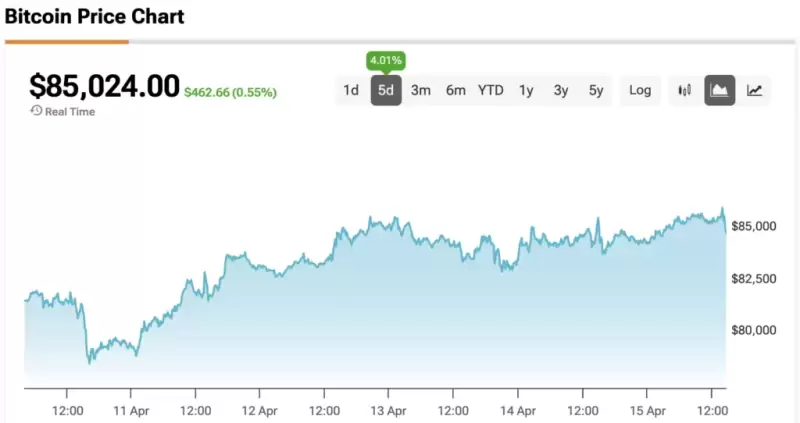 |
|
 |
|
 |
|
 |
|
 |
|
 |
|
 |
|
 |
|
 |
|
 |
|
 |
|
 |
|
 |
|
 |
|
 |
|
While stocks sag and bond yields climb, Bitcoin just pulled off a stealthy comeback. The world's largest crypto rose nearly 7% over the past week to around $84,000

Bitcoin is outperforming as traditional markets struggle and bond yields rise.
The world’s largest crypto pulled off a stealthy comeback as stocks sank and bond yields climbed. Bitcoin is showing unusual strength.
Despite the gloomy economic backdrop, the world’s leading cryptocurrency pulled off a surprising feat. As S&P 500 (SPY) and Nasdaq (NDAQ) hit one-year lows and bond yields soared, crypto trading firm Wintermute observed that Bitcoin “held up relatively well, broadly revisiting price levels from around the U.S. election period.”
This is a big shift from past crises, when Bitcoin usually dived deeper and faster than the rest. But this time, as the world’s largest economy faced a crucial moment, Bitcoin managed to stay afloat.
Relative strength is a sign of maturity, said economists at the firm.
But it’s not just macro trends keeping Bitcoin afloat. Analyst Alex Obchakevich told Cointelegraph that Bitcoin’s growing institutional presence—especially via ETFs—is giving it a new identity as “digital gold.”
This is in contrast to stocks, which are largely driven by short-term macro trends. But to truly understand Bitcoin’s resilience, we need to look at the broader economic picture.
Cooling Inflation Could Keep Crypto Climbing
The economic data is shifting. U.S. Bureau of Labor Statistics figures show that the Consumer Price Index dipped 0.1% month-on-month in March. This is the first decline since December 2020, signaling a slowdown in inflation.
The world’s largest economy had seen an annual inflation rate of 0.4% in February, but it slid to -0.2% in March. Economists had anticipated a 0.3% decline.
Meanwhile, Producer Price Index growth also slowed down from 0.6% to 0.1% in March. This is compared to the anticipated 0.4% decline.
However, the U.S. PPI growth had slid from 0.6% to -0.1%, whereas economists predicted a 0.4% decline.
But don’t get too comfy. Rising global trade tensions, especially from new U.S. tariffs, could push inflation back up, warned Wintermute.
Public Companies Boost Bitcoin Holdings
In other news, public companies are boosting their Bitcoin presence. According to Bitwise, 12 new firms added Bitcoin in Q1, pushing total corporate holdings up 16% to 688,000 BTC.
This stash is now worth around $57 billion. Among them, 10 firms held at least 10,000 BTC by the end of March.
Michael Saylor’s Strategy (MSTR) led the charge with another $285 million Bitcoin purchase last week. The firm now holds a staggering 531,644 BTC, acquired at an average cost of $67,556.
This puts them deep in the green—sitting on billions in unrealized gains, according to Saylortracker. Only a 30% drop from peak prices would wipe out all of Saylor’s firm’s profit from its seven-year crypto journey.
One standout? Hong Kong’s Ming Shing Group (HKG:8498) grabbed 833 BTC through its subsidiary.
And in Japan, Metaplanet (JP:3350) scooped up 319 more BTC this week—taking its total to over 4,500 coins. It now ranks 10th among public holders.
Disclaimer:info@kdj.com
The information provided is not trading advice. kdj.com does not assume any responsibility for any investments made based on the information provided in this article. Cryptocurrencies are highly volatile and it is highly recommended that you invest with caution after thorough research!
If you believe that the content used on this website infringes your copyright, please contact us immediately (info@kdj.com) and we will delete it promptly.
-

-

-

-

-
![A wave of capital is flowing out of Ethereum [ETH] and into Tron [TRX] A wave of capital is flowing out of Ethereum [ETH] and into Tron [TRX]](/assets/pc/images/moren/280_160.png)
-

-

- Bitcoin (BTC) Spot Exchange-Traded Funds Saw $872M in Net Outflows Between April 3 and April 10
- Apr 16, 2025 at 07:05 am
- Spot Bitcoin (BTC) exchange-traded funds saw a total of $872 million in net outflows between April 3 and April 10, causing traders to wonder if overall interest in Bitcoin is fading.
-

-

























































![A wave of capital is flowing out of Ethereum [ETH] and into Tron [TRX] A wave of capital is flowing out of Ethereum [ETH] and into Tron [TRX]](/uploads/2025/04/16/cryptocurrencies-news/articles/wave-capital-flowing-ethereum-eth-tron-trx/middle_800_480.webp)
